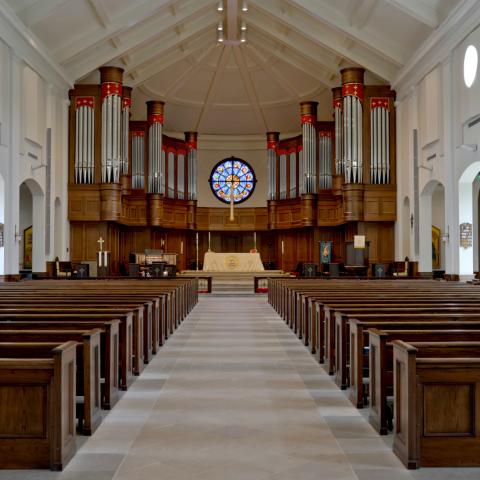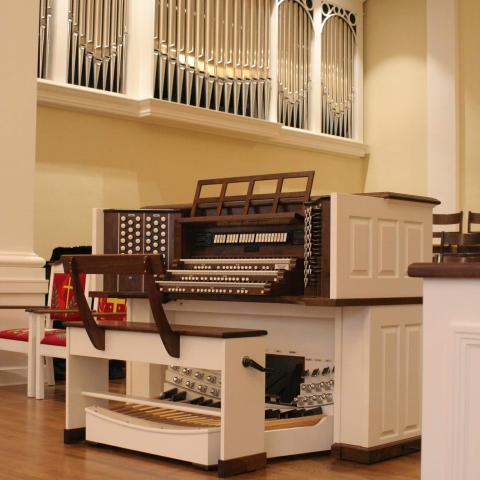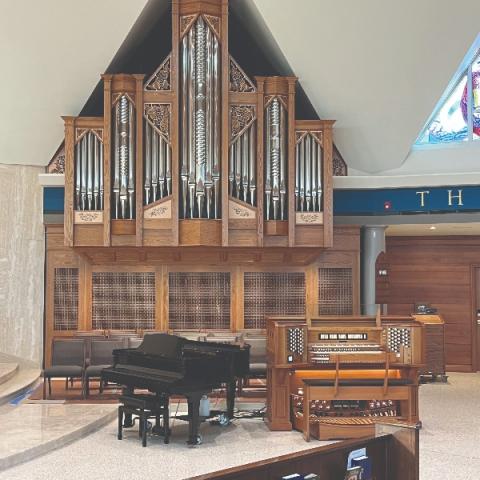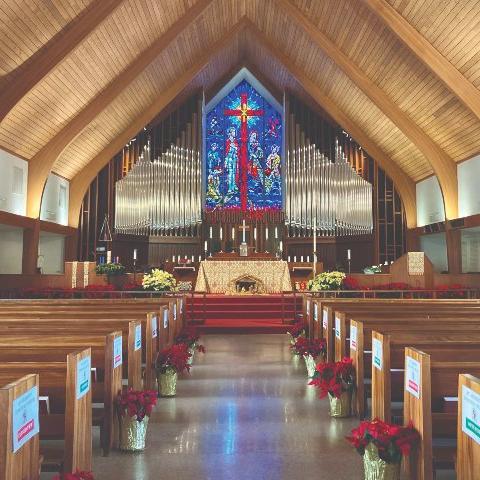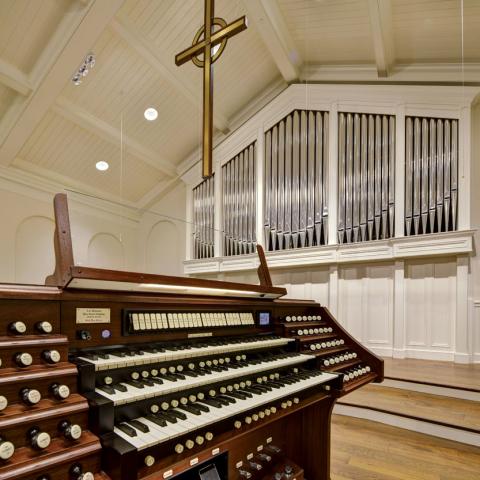Buzard Pipe Organ Builders, Champaign, Illinois; Countryside Community Church, Omaha, Nebraska

Opus 47, completed November 2020
From the builder
Countryside Community Church is the Christian participant in the new “Tri-Faith Initiative,” a campus that includes the church, a mosque, and a synagogue. Congregations from the three Abrahamic faiths bought a large tract of land and developed it together as a demonstration of how well our three faiths can live together in peace and harmony. Buzard Pipe Organ Builders was selected for this important commission based on our noble sound and creative designs. It was a privilege and honor to work with the architects, parishioners, and clergy to create a most unique instrument that solidly represents centuries of sacred musical tradition.
This three-manual organ of 25 stops (30 ranks) includes preparations for future addition of nine more stops on the Great, Swell, and Pedal, a “Grande Choeur” of approximately 10 stops as the third manual division, and three Walker digital pedal stops.
The church originally planned on moving the much smaller organ from their previous building. As the new building took shape, parishioners Roy and Gloria Dinsdale came forward with a significant financial gift for an organ, better suited to the larger sanctuary. It was our challenge to engineer the instrument for the somewhat diminutive already-built chamber, which was bisected by steel beams and cross-bracing and a vent for a lower-level kitchen.
The visual design embodies several of the congregation’s faith tenets, as described to us by then senior pastor Eric Elnes: our life’s journey from a chaotic, dark earth upward to heavenly order of peace and light; the trinity and elements of “three;” and the coexistence of science and faith as represented by the front pipes’ mouths, which form a perfect sine wave. In order to encourage the “dark-to-light” journey as one gazes upward at the façade, the three levels of pipes are made of increasingly rich alloys of tin, the visually brightest at the top. Although difficult to see in the photograph, the Pedal 16′ Bourdon pipes in the very back, top right quadrant of the chamber have been interpreted by many parishioners as a visual representation of a skyline of the Heavenly City. The top level Trombas seem to many to be hands at prayer.
In this organ, as in several of our newest instruments, the Great is divided into enclosed and unenclosed sections. The bold and clear principal chorus is unenclosed, while the colorful stops are in an expression box. The enclosed Great may be coupled to other manuals and the pedal at any pitch and may function either as a “Choir Division” or a “Solo Division” depending on which stops are drawn. This allows us the freedom to give any musical purpose we choose to an independent third manual division. By nature of the two mixtures in the Swell, one low, the other high-pitched, this division can function as a foil to the Great as the Swell or a “Positif.” The musical personality of the Grand Choeur, being prepared for future addition, is still under discussion.
The heart of any Buzard organ is the Swell division. It is the workhorse for accompanying, coloring and contrasting with the other divisions, and providing the “powerhouse” reed battery for our distinctive full Swell. The Trombas, sort of a reed equivalent to the Great and Pedal First Open Diapasons, louden and thicken the texture of full organ, over and above the significant contribution of the Swell battery to the ensemble.
Organist Alex Ritter served as a project manager on the church’s behalf; Rick MacInnes was the chair of Countryside Church’s Relocation Committee; Daniel Loven-Crum was the patient person at the church who arranged logistics of meals brought in for us, housing, and complete access to the building during what proved to be a much-prolonged installation, with months of hiatus while we were locked down by the pandemic and closed by the State of Illinois.
The staff of Buzard Pipe Organ Builders who participated in this instrument’s design, construction, installation, and administrative support are:
Charles Eames
Shane Rhoades
Michael Meyer
Felix Franken
Christopher Goodnight
John Switzer
Jeff Hoover
Lauren Kasky
Keith Williams
Jefrey Player
Fredrick Bahr
Andrew Woodruff
—John-Paul Buzard
President & Artistic Director
Buzard Pipe Organ Builders, LLC
From the organist
For Countryside, the journey to the completion of this instrument was a wild ride. The plan was to rebuild and relocate our existing Reuter organ to the new building. Construction of the new church was well underway when we received a generous donation from Roy and Gloria Dinsdale to commission the design and construction of a new pipe organ. Imagine our excitement and concern. The architectural plans were complete. Ground had been broken. The foundation and structural supports were already in place. The interior walls surrounding the organ chamber were scheduled to go up in three months, and a grand opening was almost exactly a year away. The Dinsdale’s generosity, however, inspired us to dream big and move quickly. This was a unique opportunity: to design and build an instrument that would be as musically exquisite as it was aesthetically dynamic—the first pipe organ installation in Omaha in nearly twenty years.
An organ committee was formed, and I cautioned that we should not rush the process, but we did need to narrow our choices down quickly so the builder would have some time, although limited, to work with the architects on any needed changes. We were fortunate to find a partner uniquely suited for the situation in the team at Buzard Pipe Organ Builders. The committee quickly fell in love with the Buzard sound, but the relationship proved beneficial in other ways as well. The success of our Opus 47 despite numerous challenges is a testament to their engineering prowess and ingenuity. For example, the organ chamber was designed for a smaller instrument, and some structural support beams had made their way into the space, causing an obstacle course for a larger instrument. Not only did the Buzard team circumvent the obstacle course, they were able to fit an organ twice the size without compromising the instrument’s integrity.
For us and for our donors, an important consideration was a visual design to match the beauty of the sanctuary and punctuate it by symbolizing our values and signifying the organ’s role in our future. In reviewing builders’ designs, we felt that Buzard’s stood out, weaving contemporary and traditional elements together, while making the instrument appear as though it was always meant to be there. Their work on our design exceeded our expectations. An organ is a convergence of art and science, and this is beautifully reflected in the façade design, which makes a strong but not obtrusive statement.
In the context of Countryside’s involvement in the Tri-Faith Initiative, the symbolism is compelling. Our purpose is not to borrow from our Tri-Faith partners or change who we are. We are there to stand in solidarity, learn from one another, and use that knowledge to grow stronger in our own faith.
From a tonal perspective, our intention was similar—avoid eclecticism that too often results in a lack of unity, and instead seek a tonal design with integrity that is historically informed and benefits from sharing of the best building practices from across historical periods with an eye towards the future. We cultivated a tonal design that embodies the diversity, drama, expressiveness, and contrast needed for liturgy. The result is unique—a depth and breadth of individual sounds, yet strong unified choruses, articulate and contrapuntally clear voicing without austerity.
The pandemic put a wrench in our plans to share this distinctive and wonderful instrument with the world. We had a strong belief that giving our congregation a chance to hear the instrument in person was very important, especially in a time such as this—after all, we could all use a pick-me-up these days. Thus, we worked with medical professionals in our congregation to curate a series of small, RSVP-only recitals, intentionally limiting capacity to maintain a safe environment. While we would have loved to pack the house with more than 500 people and bring in a special guest to perform, we were grateful to share it with members of our congregation and look forward to the time when we can safely fill the sanctuary seats and experience the majestic sound of the instrument in person.
We were pleased to partner with a firm that invests in the future of the trade by employing women and members of the next generation. My hope is to use this one-of-a-kind instrument to feature up-and-coming organists of diverse backgrounds and foster new compositions from those underrepresented in the current repertoire, ensuring a vibrant future for the instrument and expanding its audience.
What an amazing gift the Dinsdales have given to Countryside Community Church and to the broader Omaha community. It is truly a crown jewel that will be a centerpiece for liturgy and music.
—Alex Ritter
Director of Arts Ministry and Organist
Cover photo: John-Paul Buzard, digital editing by Len Levasseur
GREAT (Manual II)
16′ Double Open Diapason (metal, in façade)
8′ First Open Diapason (metal, in façade)
8′ Second Open Diapason (metal, in façade)
8′ Bourdon*
8′ Flûte Harmonique*
8′ Viola da Gamba (prepared)*
4′ Principal
4′ Spire Flute (prepared)*
2-2⁄3′ Twelfth
2′ Fifteenth
2′ Fourniture IV
1-1⁄3′ Sharp Mixture III (prepared)
16′ English Horn (prepared)*
8′ Clarinet (prepared)*
Cymbalstern*
8′ Minor Trumpet (ext Sw 16′)
8′ Tromba (ext Ped 16′)
4′ Tromba Clarion (ext Ped 16′)
8′ Major Tuba (prepared)
* enclosed
GRAND CHOEUR (Manual I, enclosed, prepared)
SWELL (Manual III, enclosed)
16′ Lieblich Gedeckt (temporary digital)
8′ Open Diapason
8′ Stopped Diapason (wood)
8′ Salicional
8′ Voix Celeste (TC)
4′ Principal
4′ Harmonic Flute
2-2⁄3′ Nazard
2′ Octavin
1-3⁄5′ Tierce
2-2⁄3′ Grave Mixture II (prepared)
1′ Plein Jeu III
16′ Bassoon
8′ Trompette
8′ Oboe
8′ Vox Humana (prepared)
4′ Clarion (ext 16′)
Tremulant
8′ Tromba (ext Ped 16′)
4′ Tromba Clarion (ext Ped 16′)
8′ Major Tuba (Gt prepared)
PEDAL
32′ Double Open Diapason (digital, prep)
32′ Subbass (digital, prepared)
16′ First Open Diapason (Walker)
16′ Second Open Diapason (Gt)
16′ Bourdon (wood)
16′ Lieblich Gedeckt (Sw, temporary, digital)
8′ Principal (metal, in façade)
8′ Salicional (Sw)
8′ Bass Flute (ext 16′ First Open, Walker)
8′ Bourdon (ext 16′ Bourdon)
8′ Gedeckt Flute (Sw 16′, temporary, digital)
4′ Choral Bass (ext 8′ Principal)
4′ Open Flute (ext 16′ Bourdon)
2-2⁄3′ Mixture IV (prepared)
32′ Contra Trombone (digital, prepared)
16′ Trombone (metal, in façade)
16′ Bassoon (Sw)
8′ Tromba (ext 16′ Trombone)
8′ Trompette (Sw)
4′ Tromba Clarion (ext 8′ Tromba)
4′ Clarion (from Sw 16′ Bassoon)
Console has standard array of sub, unison, and super octave couplers.
Currently 25 stops, 30 ranks.
Nine stops and 15 ranks prepared for future addition in the main portion of the organ.
Space for approximately 10 stops in the future Grand Choeur.
Three digital voices prepared for future addition.
All metal pipes are made by Killinger Pfeifen Freiberg.

